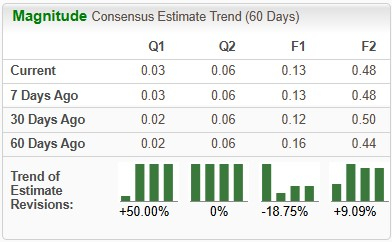BioCryst Pharmaceuticals (BCRX) is preparing to announce its financial results for the second quarter of 2025 on August 4th, prior to the market opening. Analysts predict revenues of approximately $148.85 million for the quarter. Earnings per share (EPS) are projected to be around 3 cents.
- 0.1 Analyst Estimates and Trends
- 0.2 Earnings Performance History
- 0.3 Factors Influencing Upcoming Results
- 0.4 Orladeyo Expansion and Regulatory Updates
- 0.5 Pipeline Development
- 0.6 Expense Management
- 0.7 Stock Performance and Valuation
- 0.8 BioCryst’s Strategy and Competitive Landscape
- 0.9 Investment Outlook
Related: 5 Rare Collections Set to Skyrocket in Value Within a Decade
Analyst Estimates and Trends
Recent analyst sentiment has seen some shifts. The consensus estimate for BioCryst’s 2025 EPS has decreased from 16 cents to 13 cents over the past two months. However, the forecast for 2026 EPS has risen from 44 cents to 48 cents during the same period, indicating potential longer-term optimism.
Earnings Performance History
BioCryst’s earnings history presents a mixed picture. Over the last four quarters, the company has exceeded earnings estimates in two quarters, met expectations in one, and fallen short in another. On average, the company has delivered an earnings surprise of 12.94% over these four quarters. The most recent quarter saw a substantial earnings surprise of 100%.
Factors Influencing Upcoming Results
BioCryst Pharmaceuticals’ revenue is primarily generated through sales of Orladeyo (berotralstat), an oral capsule. Orladeyo is approved in the United States and other global markets for preventing hereditary angioedema (HAE) attacks in adults and pediatric patients aged 12 years and older. Increased prescriptions and volume growth are expected to have driven revenue growth for Orladeyo.
Investors will be keen to hear updates on BioCryst’s clinical pipeline during the earnings call.
Orladeyo Expansion and Regulatory Updates
A regulatory application is currently under review by the FDA to expand Orladeyo’s label to include younger HAE patients (aged two to eleven years) using an oral granule formulation. A decision from the FDA is anticipated by September 12, 2025. If approved, Orladeyo would become the first targeted oral prophylactic therapy for children under 12 with HAE. BioCryst also plans to submit regulatory filings for label expansion in Europe, Japan, and Canada in 2025.
Pipeline Development
BioCryst’s pipeline includes BCX17725, an investigational KLK5 inhibitor. The FDA has cleared the company’s investigational new drug application for this candidate. BioCryst plans to begin enrolling patients in an early-stage study of BCX17725 for the treatment of Netherton syndrome.
Expense Management
Research and development (R&D) expenses in the upcoming quarter are expected to be lower year-over-year due to the company’s pipeline restructuring, which involved discontinuing its Factor D programs, BCX10013 and BCX9930.
Selling, general, and administrative (SG&A) expenses are projected to have increased in the second quarter, primarily due to increased commercial investments supporting the global launch of Orladeyo.
Stock Performance and Valuation
BioCryst Pharmaceuticals’ stock has risen 9.3% year-to-date, outperforming the industry’s 4.5% growth. The stock has also outperformed the S&P 500 and the broader sector during the same period. However, it is currently trading below its 50 and 200-day moving averages.
Currently, BioCryst Pharmaceuticals’ stock is trading at a premium compared to the industry average. The company’s price/sales ratio is 3.51, higher than the industry average of 2.32.
BioCryst’s Strategy and Competitive Landscape
BioCryst Pharmaceuticals is focused on improving the lives of individuals with HAE and other rare diseases. The company utilizes its structure-guided drug design expertise to develop oral small-molecule and injectable protein therapeutics. BioCryst’s strategy includes commercializing its therapies and aiming to fund these efforts through increasing profitability by concentrating on rare disease markets, managing commercialization costs, and allocating resources efficiently.
However, BioCryst faces competition from other pharmaceutical and biotechnology companies. Ionis Pharmaceuticals is awaiting an FDA decision on its regulatory filing for donidalorsen for HAE, expected by August 21, 2025. Ionis’ partner, Otsuka, has also submitted a similar filing in the EU. If approved, donidalorsen will compete with BioCryst’s Orladeyo.
Intellia Therapeutics is evaluating NTLA-2002 in a late-stage study for treating HAE and plans to submit a regulatory filing in the second half of 2026.
In Netherton syndrome, BioCryst faces competition from Quoin Pharmaceuticals, Boehringer Ingelheim, and Daiichi Sankyo, which are evaluating their respective candidates in mid-to-late-stage studies.
Investment Outlook
BioCryst Pharmaceuticals is focused on expanding the market for Orladeyo through increased global commercial activities, which could give it an advantage in the HAE treatment space. Successful label expansion of Orladeyo will further strengthen its commercial position and enhance shareholder value. The company is also diversifying its pipeline to include candidates for other rare disease indications.
With clinical studies progressing well, current investors may consider holding their positions for potential long-term gains, regardless of the second-quarter results. New investors may find price dips to be opportune times to add BioCryst to their portfolios.


